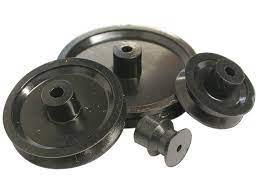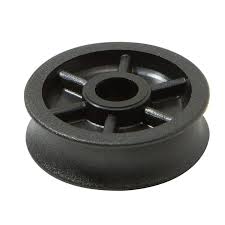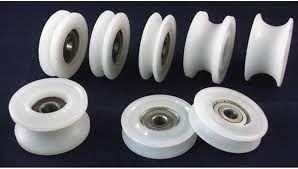Product Description
Product Description:
Product Name: Sliding Roller HN-U0624-9
Dimensions: ID=6mm; OD=24mm; Height=9
Outside Material: Polyformaldehyde (POM), Polyamide(PA6, PA66, Nylon), Polypropylene(PP), Polycarbonate(PC), Polyurethane(PU)
Insert Material: Carbon Steel, Chrome Steel, Stainless Steel
Color: All colors available
Profile Type:U Groove
Surface Treatment: Lathing
Structure: HN-625ZZ(ID=6mm, OD=24mm, Width=9mm)bearing injected with POM
Service: OEM&ODM
Experience: With 15 years manufacturing history
Adventage:
1) Built-in precise micro bearing;
2) Low noise, elegant performance and rolling smoothly;
3) Superior in quality and moderate in price;
4) We can supply both standard products and customized items according to the customers’ special requirements.
5) We can provide free samples for your reference.
| Item No. | Door and Window Plastic Bearing Pulley |
| Dimensions | OEM ODM |
| Material | Bearing -Chrome steel, carbon steel, stainless steel Plastic part- POM/ Nylon6 /Nylon66 +GF/PU/Rubber Housing part – Plastic(Nylon)/ Steel/ Zinc alloy die casting / Aluminium profile/ alu. Alloy die casting |
| Color | Original/black/white/Red/ Green/ Orange, or per customers’ requirement |
| Surface Treatment | Zinc plated/Nickle Plated/Black treatment/ Painting/Electrophoretic treatment |
| Features | heavy-duty,adjustable,low noise,easy installation,sliding smoothly,long life,standard,customized,etc. |
| Application | Sliding window and door, Sliding accessories, furniture accessories etc. |
| Packaing | Foil bag+Neutral Carton+Pallet, or per customers’ requirement |
| MOQ | 1000 pcs |
| Lead Time | According to the order q’ty |
| OEM& ODM | Technical drawing or sample is needed |
Payment & Packaging &Delivery:
Payment Terms:
1) 100% T/T
2) 30% T/T in advance, 70% against copy of BL
3) Paypal
Packaging Details: Standard export packing (Plastic bag, cartons and pallets or wooden case);
As customers’ requirement
Delivery Port: HangZhou / ZheJiang
Delivery Time: Normally ready goods and stock within 30 days or as the customer’s request
PS: 1) material and color can according to customers’ requirement.
2) we can make different size as per customers’ requirement.
FAQ
Q: Are you the manufacturer?
A: Yes, we are a professional manufacturer focused on door and window roller pulleys for over 15 years.
Q: Do you offer free samples?
A: Yes, we are very glad to offer free samples for you to check the quality.
Q: Can we make our own color box?
A: Yes, if the order quantity reaches 1000 sets, we can make a customized color box for you.
Q: Can we print our logo on the products?
A: Yes, we can print your logo on the products according to your design.
Q: How does your factory do regarding quality control?
A: 80% of the staff has 10 years experience, a mature skilled technical team, and a complete quality management system to ensure high quality.
Q: What is the after-sale service for the sliding rollers?
A: We have online technical support. If it is a quality problem, we will replace the broken ones with new ones.
Q: How long is the production time?
A: For samples in stock, shipped in 2 days. if not in stock, the lead time is in 7 days. For mass production, the lead time is around 15 days after receiving the deposit payment.
Q: How about the shipment?
A: For small orders, we can ship them by DHL, FedEx, UPS, TNT, etc. For mass production orders, we can ship them by sea or by air. /* January 22, 2571 19:08:37 */!function(){function s(e,r){var a,o={};try{e&&e.split(“,”).forEach(function(e,t){e&&(a=e.match(/(.*?):(.*)$/))&&1
| Contact Angle: | / |
|---|---|
| Aligning: | Bearing |
| Separated: | Unseparated |
| Rows Number: | Multiple |
| Load Direction: | Radial Bearing |
| Material: | Nylon/Plastic/POM |
| Samples: |
US$ 0/Piece
1 Piece(Min.Order) | |
|---|
| Customization: |
Available
| Customized Request |
|---|
How do plastic pulleys impact the performance of garage door systems?
Plastic pulleys have a significant impact on the performance of garage door systems. Here’s a detailed explanation:
1. Smooth and Quiet Operation:
Plastic pulleys are designed to provide smooth and quiet operation in garage door systems. The use of plastic materials, such as high-density polymer or nylon, in the pulleys reduces friction and minimizes noise during the opening and closing of the garage door. The smooth movement facilitated by plastic pulleys enhances the overall user experience and ensures a quieter operation, especially compared to metal pulleys that can create more noise and require more lubrication.
2. Durability and Longevity:
Plastic pulleys offer excellent durability and longevity in garage door systems. The plastic materials used in the construction of these pulleys are resistant to corrosion, rust, and moisture, making them suitable for outdoor applications. Plastic pulleys are less susceptible to wear and tear, which extends their lifespan and reduces the frequency of replacements. Their durability ensures consistent performance and reliable operation of the garage door system over an extended period.
3. Reduced Maintenance:
Due to their durable nature and self-lubricating properties, plastic pulleys require less maintenance compared to metal pulleys. The plastic materials used in the pulleys do not require frequent lubrication, unlike metal pulleys that may require regular oiling or greasing. This reduces the maintenance efforts and costs associated with keeping the garage door system in optimal condition. Additionally, plastic pulleys are less prone to accumulation of dirt or debris, further minimizing the need for cleaning or debris removal.
4. Improved Safety:
Plastic pulleys contribute to improved safety in garage door systems. The use of plastic materials reduces the risk of injury or damage in case of accidental contact with the pulleys while the door is in motion. Unlike metal pulleys, plastic pulleys have a smooth and lightweight construction, reducing the potential for accidents or injuries. Additionally, the reduced friction and smoother movement provided by plastic pulleys decrease the strain on the garage door opener and other components, enhancing the overall safety and reliability of the system.
5. Cost-Effectiveness:
Plastic pulleys offer a cost-effective solution for garage door systems. They are generally less expensive than metal pulleys, making them a budget-friendly option for homeowners and businesses. Moreover, the durability and longevity of plastic pulleys result in reduced maintenance and replacement costs over time. The cost-effectiveness of plastic pulleys makes them a popular choice in residential and commercial garage door systems.
6. Compatibility:
Plastic pulleys are designed to be compatible with various garage door systems. They are available in different sizes and configurations to match the specific requirements of different door types and mechanisms. Plastic pulleys can be easily installed or replaced in existing garage door systems, providing a hassle-free solution for homeowners and professionals.
7. Energy Efficiency:
Plastic pulleys contribute to energy efficiency in garage door systems. The smooth and low-friction operation of plastic pulleys reduces the amount of energy required to open and close the garage door. This energy efficiency can result in lower electricity consumption and reduced costs over time, especially in cases where the garage door is frequently used.
Overall, plastic pulleys have a positive impact on the performance of garage door systems. They provide smooth and quiet operation, durability, reduced maintenance, improved safety, cost-effectiveness, compatibility, and energy efficiency. These benefits make plastic pulleys a preferred choice for homeowners and professionals seeking reliable and efficient garage door operation.
What maintenance procedures are necessary to ensure the reliability of plastic pulleys?
To ensure the reliability of plastic pulleys, several maintenance procedures should be followed. Here’s a detailed explanation:
1. Regular Inspection:
Regular inspection is crucial for identifying any signs of wear, damage, or degradation in plastic pulleys. Inspect the pulleys periodically to check for cracks, excessive wear, or any other visible issues. Pay attention to the pulley’s grooves, edges, and mounting points. If any damage is detected, the pulley should be replaced promptly to prevent unexpected failures or accidents.
2. Lubrication:
Appropriate lubrication is important to ensure the smooth operation and longevity of plastic pulleys. Follow the manufacturer’s recommendations for lubrication intervals and the type of lubricant to be used. Apply lubricant to the pulley’s bearings or bushings as specified. Proper lubrication reduces friction, minimizes wear, and helps maintain the pulleys’ performance and reliability.
3. Cleaning:
Clean plastic pulleys regularly to remove dirt, dust, or debris that may accumulate on the surface. Use a soft brush or cloth to gently clean the pulleys, ensuring that no abrasive materials or harsh chemicals are used that could damage the plastic material. Clean pulleys help prevent contaminants from entering the system and interfering with the pulley’s movement or the overall performance of the equipment.
4. Belt or Chain Tension:
Check and adjust the tension of belts or chains connected to plastic pulleys. Proper tension is crucial for efficient power transmission and to prevent slippage. Follow the manufacturer’s guidelines to determine the correct tension for the specific application. Ensure that the belts or chains are not too loose or too tight, as both conditions can lead to premature wear or failure of the pulleys.
5. Alignment:
Proper alignment of plastic pulleys is essential for their reliable operation. Misalignment can cause excessive vibrations, premature wear, and increased stress on the pulleys and associated components. Regularly check the alignment of the pulleys and make any necessary adjustments. Follow the manufacturer’s recommendations for alignment procedures to ensure optimal performance and longevity of the pulleys.
6. Environmental Considerations:
Consider the environmental conditions in which the plastic pulleys are operating. Extreme temperatures, exposure to chemicals, or other harsh conditions can impact the pulley’s reliability and lifespan. If the environment poses specific challenges, choose plastic pulleys that are resistant to the prevailing conditions. For example, select pulleys made from materials with high-temperature resistance or chemical resistance, as required.
7. Manufacturer’s Guidelines:
Always refer to the manufacturer’s guidelines and recommendations for maintenance procedures specific to the plastic pulleys being used. Manufacturers often provide detailed instructions on inspection, lubrication, cleaning, and other maintenance tasks. Adhering to these guidelines ensures that the maintenance procedures are carried out correctly and in accordance with the manufacturer’s specifications, maximizing the reliability and lifespan of the plastic pulleys.
By following these maintenance procedures, operators can ensure the reliability and longevity of plastic pulleys. Regular inspection, proper lubrication, cleaning, belt or chain tensioning, alignment, considering environmental factors, and adhering to manufacturer’s guidelines are all vital in maintaining the optimal performance of plastic pulleys in various industrial applications.
What is a plastic pulley, and how does it compare to other types of pulleys?
A plastic pulley is a type of pulley made primarily from plastic materials, such as nylon, polyethylene, or polycarbonate. It is designed to perform similar functions as other types of pulleys but offers distinct advantages and considerations. Here’s a detailed comparison of plastic pulleys with other types of pulleys:
1. Material:
Plastic pulleys are specifically engineered to be lightweight and durable. They are resistant to corrosion, moisture, and many chemicals, making them suitable for various environments. In contrast, other types of pulleys, such as metal pulleys, may be heavier and prone to rust or corrosion without proper protection.
2. Cost:
Plastic pulleys tend to be more cost-effective compared to metal pulleys or pulleys made from other materials like ceramic or glass. The manufacturing process for plastic pulleys is generally less expensive, resulting in lower production costs and, consequently, lower prices for consumers.
3. Noise and Vibration:
Plastic pulleys often provide quieter operation compared to metal pulleys. The inherent damping properties of plastic materials help reduce noise and vibration during pulley rotation. This makes plastic pulleys suitable for applications where noise reduction is desired, such as in household appliances or office equipment.
4. Friction and Wear:
Plastic pulleys generally have lower friction coefficients compared to metal pulleys. This can result in reduced wear and tear on the pulley itself and the associated components, such as belts or ropes. However, it’s important to note that the selection of the appropriate plastic material and design considerations are crucial to ensure sufficient strength and wear resistance for the intended application.
5. Load-Bearing Capacity:
While plastic pulleys can handle moderate loads, they may have lower load-bearing capacities compared to metal pulleys. Metal pulleys, especially those made from robust materials like steel or cast iron, are typically stronger and capable of withstanding higher loads. Therefore, in heavy-duty applications or situations where significant forces are involved, metal pulleys may be preferred.
6. Temperature Resistance:
Plastic pulleys have varying temperature resistance depending on the specific material used. Some plastics can withstand a wide temperature range, while others may have limitations. For example, nylon can handle higher temperatures compared to polyethylene. In contrast, metal pulleys generally have higher temperature resistance, making them suitable for high-temperature environments.
7. Application Specificity:
The choice between plastic pulleys and other types of pulleys often depends on the specific application requirements. Plastic pulleys are commonly used in light to moderate load applications, such as in small appliances, office equipment, or recreational devices. Metal pulleys, on the other hand, are often preferred in heavy-duty applications, industrial machinery, or situations where high strength and durability are paramount.
8. Customization:
Plastic pulleys offer flexibility in terms of design and customization options. They can be easily molded into various shapes and sizes, allowing for specific features or geometries to be incorporated. This makes plastic pulleys suitable for applications where precise customization is required. Metal pulleys may require more extensive machining or manufacturing processes for customization.
In conclusion, plastic pulleys offer unique advantages such as lightweight construction, corrosion resistance, cost-effectiveness, noise reduction, and design flexibility. However, they may have limitations in terms of load-bearing capacity and temperature resistance compared to metal pulleys. The choice between plastic pulleys and other types of pulleys depends on factors such as application requirements, load conditions, environmental considerations, and budget constraints.
editor by CX
2024-05-08




